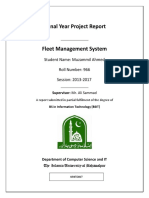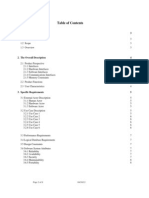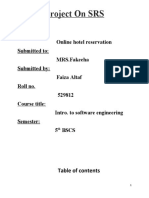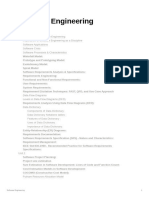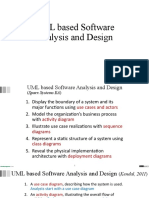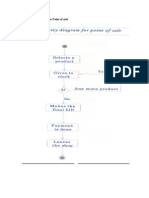Srs Client Management System
Srs Client Management System
Uploaded by
Sourabh Singh ThakurCopyright:
Available Formats
Srs Client Management System
Srs Client Management System
Uploaded by
Sourabh Singh ThakurCopyright
Available Formats
Share this document
Did you find this document useful?
Is this content inappropriate?
Copyright:
Available Formats
Srs Client Management System
Srs Client Management System
Uploaded by
Sourabh Singh ThakurCopyright:
Available Formats
lOMoARcPSD|41337686
SRS Client Management System
Software Project Management (Amrita Vishwa Vidyapeetham)
Scan to open on Studocu
Studocu is not sponsored or endorsed by any college or university
Downloaded by Sourabh Singh Thakur (st310158@gmail.com)
lOMoARcPSD|41337686
Software Requirements
Specification
BLEND
Clients Management System
Downloaded by Sourabh Singh Thakur (st310158@gmail.com)
lOMoARcPSD|41337686
1. Introduction 3
1.1. Purpose 3
1.2. Scope of Project 3
1.3. Glossary 3
1.4. Overview of Document 4
2. Overall Description 5
2.1 System Environment 5
2.2 Functional Requirements Specification 5
2.2.1 Employee Use Case 5
2.2.2 Manager Use Cases 6
Use case: Manage Quote 8
Use case: Manage Employee 11
2.3 User Characteristics 13
2.4 Non-Functional Requirements 13
3. Requirements Specification 14
3.1 Functional Requirements 14
3.1.1 Log time 14
3.1.1 User login 14
3.2.2 Add new client 15
3.2.3 Update client information 15
3.2.4 Remove client 16
3.2.5 Manage Quote 17
3.2.6 Manage Invoice 17
3.2.7 Manage Project 18
3.2.7 Manage Employee 19
3.3 Detailed Non-Functional Requirements 20
3.3.1 Security 20
Downloaded by Sourabh Singh Thakur (st310158@gmail.com)
lOMoARcPSD|41337686
1. Introduction
1.1. Purpose
The purpose of this document is to present a detailed description of the Clients Management System. It will
explain the purpose and features of the system, the interfaces of the system, what the system will do, the
constraints under which it must operate and how the system will react to external stimuli. This document is
intended for both the stakeholders and the developers of the system.
1.2. Scope of Project
This software system will be a web tool for managing clients for a software development company. This
system will be designed to maximize the managers productivity by providing tools for generating quotes,
invoices as well as reviwing employeers productivity. Currently, the company is using muliple tools for this
purpise which is time-consuming and costly.
More specifically, this system is designed to allow the company managers to review and compare the time
logs from the employees, create quotes for the potential clients, as well as issue invoices for the work. The
system will alow the managers to create projects the employees are working on and use the logged time by
the employees on a similar projects to make better estiamtions and planning in the future. Since the company
is working on different markets, the system will allow generating invoices and quotes in multiple currencies.
1.3. Glossary
Term Definition
Employee A person that is using the system for tracking his daily hours.
Software Requirements A document that completely describes all of the functions of a proposed
Specification system and the constraints under which it must operate. For example, this
document.
Downloaded by Sourabh Singh Thakur (st310158@gmail.com)
lOMoARcPSD|41337686
Stakeholder Any person with an interest in the project who is not a developer.
User A person tht is using the sytem.
Database A collection of stored related data
1.4. Overview of Document
The next chapter, the Overall Description section, of this document gives an overview of the functionality of
the product. It describes the informal requirements and is used to establish a context for the technical
requirements specification in the next chapter.
The third chapter, Requirements Specification section, of this document is written primarily for the
developers and describes in technical terms the details of the functionality of the product.
Both sections of the document describe the same software product in its entirety, but are intended for
different audiences and thus use different language.
Downloaded by Sourabh Singh Thakur (st310158@gmail.com)
lOMoARcPSD|41337686
2. Overall Description
2.1 System Environment
The Clients Management System has two active actors and one coopeatating system. Both the Employee
and the Manager access the tool through the Internet. The system can’t be used without authorization by the
Users.
The sustem is devided into three independent sections. The Manager access the entire system directly while
the Employee has access only to the Time Logs sub-section.
2.2 Functional Requirements Specification
This section outlines the use cases for both Employee and Manager separately.
2.2.1 Employee Use Case
Use case: Log time
Diagram:
Downloaded by Sourabh Singh Thakur (st310158@gmail.com)
lOMoARcPSD|41337686
Figure 1 - Employee Use Case
Brief Description
The Employee accesses the Clients Management System on the web, logs in the system and logs time for
particular day.
Initial Step-By-Step Description
Before this use case can be initiated, the Reader has already accessed the Clientns Management System.
1. The Employee sings in the system using his credentials assigned.
2. The system displays a dasgboard page with time logs list.
3. The Employee logs time.
Xref: Section 3.2.1, Log Time
2.2.2 Manager Use Cases
The Manager has the following sets of use cases:
Downloaded by Sourabh Singh Thakur (st310158@gmail.com)
lOMoARcPSD|41337686
Figure 2 - Manager Use Cases
Use case: User log in
Diagram:
Brief Description
Both Manager or Employee logs in the system
Initial Step-By-Step Description
Before this use case can be initiated, the Manager has already accessed the landing page page of the system.
1. The User fills the email address and password.
2. The system verifies the credentials. logs in and redirects the user to the Dashboard.
Xref: Section 3.2.2, User log in;
Use case: Manage Client
Diagram:
Downloaded by Sourabh Singh Thakur (st310158@gmail.com)
lOMoARcPSD|41337686
Brief Description
The Manager creates a new client, updates information about a current client, deletes a client or views
additional details about a client.
Initial Step-By-Step Description
Before this use case can be initiated, the Manager has already accessed the Dashboard page of the system.
3. The Manager clicks on the Clients form the main menu.
4. The system redirects the user to a Clients List page.
5. The Manager choses to add a new client or to update, delete or view an existing one.
6. If the Manager chooses to add new or update client, the system presents an empty form for filling
information or a filled form for updating information.
7. The Manager fills the information ans submits the form.
8. The system verifies the information and returns the Manager to the Clients List page.
9. If the manager chooses to delete a Clinet, the system prompts for a delete confirmation.
10. The system verifies and executes the action and returns the Manager to the Clients List page.
Xref: Section 3.2.3, Manage Client;
Use case: Manage Quote
Diagram:
Downloaded by Sourabh Singh Thakur (st310158@gmail.com)
lOMoARcPSD|41337686
Brief Description
The Manager enters a new Quote or updates information about an existing one.
Initial Step-By-Step Description
Before this use case can be initiated, the Manager has already accessed the Dashboard page of the system.
1. The Manager clicks on the Quotes link form the main menu.
2. The system redirects the user to a Quotes List page.
3. The Manager choses to add a new client or to update, delete or download PDF for an existing one.
4. If the Manager chooses to add new or update existing, the system presents an empty form for filling
information or a filled form for updating information.
5. The Manager fills the information ans submits the form.
6. The system verifies the information and returns the Manager to the Quotes List page.
7. If the manager chooses to delete a Quote, the system prompts for a delete confirmation.
8. The system verifies and executes the action and returns the Manager to the Quotes List page.
9. If the manager chooses to download a PDF, the system automatically dowloads a PDF.
Xref: Section 3.2.4 Manage Quote
Use case: Manage Invoice
Diagram:
Downloaded by Sourabh Singh Thakur (st310158@gmail.com)
lOMoARcPSD|41337686
Brief Description
The Manager enters a new Invoice or updates information about an existing one.
Initial Step-By-Step Description
Before this use case can be initiated, the Manager has already accessed the Dashboard page of the system.
1. The Manager clicks on the Invoices link form the main menu.
2. The system redirects the user to a Invoices List page.
3. The Manager choses to add a new invoice or to update, delete or download PDF for an existing one.
4. If the Manager chooses to add new or update existing, the system presents an empty form for filling
information or a filled form for updating information.
5. The Manager fills the information ans submits the form.
6. The system verifies the information and returns the Manager to the Invoices List page.
7. If the manager chooses to delete an Invoice, the system prompts for a delete confirmation.
8. The system verifies and executes the action and returns the Manager to the Invoices List page.
9. If the manager chooses to download a PDF, the system automatically dowloads a PDF.
Xref: Section 3.2.5, Manage Invoice
Use case: Manage Project
Diagram:
Downloaded by Sourabh Singh Thakur (st310158@gmail.com)
lOMoARcPSD|41337686
Brief Description
The Manager enters a new Project or updates information about an existing one.
Initial Step-By-Step Description
Before this use case can be initiated, the Manager has already accessed the Dashboard page of the system.
1. The Manager clicks on the Settings->Projects link form the main menu.
2. The system redirects the user to a Projects List page.
3. The Manager choses to add a new project or to update or delete an existing one.
4. If the Manager chooses to add new or update existing, the system presents an empty form for filling
information or a filled form for updating information.
5. The Manager fills the information ans submits the form.
6. The system verifies the information and returns the Manager to the Projects List page.
7. If the manager chooses to delete a project, the system prompts for a delete confirmation.
8. The system verifies and executes the action and returns the Manager to the Projects List page.
Xref: Section 3.2.6, Manage Project
Use case: Manage Employee
Diagram:
Downloaded by Sourabh Singh Thakur (st310158@gmail.com)
lOMoARcPSD|41337686
Brief Description
The Manager enters a new Employee or updates information about an existing one.
Initial Step-By-Step Description
Before this use case can be initiated, the Manager has already accessed the Dashboard page of the system.
1. The Manager clicks on the Settings->Employees link form the main menu.
2. The system redirects the user to a Employees List page.
3. The Manager choses to add a new project or to update or delete an existing one.
4. If the Manager chooses to add new or update existing, the system presents an empty form for filling
information or a filled form for updating information.
5. The Manager fills the information ans submits the form.
6. The system verifies the information and returns the Manager to the Employees List page.
7. If the manager chooses to delete an employee, the system prompts for a delete confirmation.
8. The system verifies and executes the action and returns the Manager to the Employees List page.
Xref: Section 3.2.7, Manage Employee
Use case: Manage Currencies
Diagram:
Brief Description
The manager previews Currencies List.
Initial Step-By-Step Description
Before this use case can be initiated, the Manager has already accessed the Dashboard page of the system.
1. The Manager clicks on the Settings->Currencies link form the main menu.
2. The system redirects the user to a Currencies List page.
Downloaded by Sourabh Singh Thakur (st310158@gmail.com)
lOMoARcPSD|41337686
Xref: Section 3.2.8, Manage Currencies
Use case: Manage Taxes
Diagram:
Brief Description
The manager previews Taxes List.
Initial Step-By-Step Description
Before this use case can be initiated, the Manager has already accessed the Dashboard page of the system.
3. The Manager clicks on the Taxes>Currencies link form the main menu.
4. The system redirects the user to a Taxes List page.
Xref: Section 3.2.9, Manage Taxes
2.3 User Characteristics
The Employee is expected to be Internet literate and to be able to track their time off the system. The
Manager is expected to be Internet literate as well.
2.4 Non-Functional Requirements
The system will be hosted on AWS EC2 instance and will be running on Apache 2. It will use PHP 7 with
MySQL. The application should be accesable through both, web and mobile devices.
Downloaded by Sourabh Singh Thakur (st310158@gmail.com)
lOMoARcPSD|41337686
3. Requirements Specification
3.1 Functional Requirements
The Logical Structure of the Data is contained in Section 3.1.1.
3.1.1 Log time
Use Case Name Log time
XRef Section 2.2.1, Log Time
Trigger The Employee access the Client Managemt System
Precondition The user is loggd in the system
Basic Path 1. The Employee clicks on the Log Time button
2. The system displays an empty form
3. The Emoployee have to select a project from a dropdown he is adding
hours for, date, number of hours as well as description.
4. One the information are filled, the Employee clicks save
5. The system validates the input and returns the Employee to the Time
Logs list or back to the form if there were errors.
Alternative Paths In step 2, the Employee can deceide to cancel the action and return back to the
Time Log list.
Postcondition The time is logged into the system.
Exception Paths The Employee can cancel the action anytime.
Other The projects dropdown contains all the projects added by the admin through
the Settings Section.
3.1.1 User login
Use Case Name User Log In
XRef Section 2.2.2, User log in
Downloaded by Sourabh Singh Thakur (st310158@gmail.com)
lOMoARcPSD|41337686
Trigger
Precondition The employ opens the web address
Basic Path 1. The user fills the email and password form
2. The user clicks log in
3. The system verifies the credentials
4. The system redirects the user to the dashboard
Alternative Paths None
Postcondition The user is logged in
Exception Paths The Employee can cancel the action anytime.
Other None
3.2.2 Add new client
Use Case Name Add new client
XRef Section 2.2.2, Manage Client
Trigger The user selects the Clients link from the main menu.
Precondition The user is signed in and he is on any of the internal pages in the system.
Basic Path 1. The Manager chooses to add a new client;
2. The system presents an empty form for filling client information
3. The Manager fills the information ans submits the form.
4. The system verifies the information and returns the Manager to the
Clients List page.
Postcondition A new client is created in the database.
Exception Paths The attempt may be abandoned at any time.
Other The client information includes name, email address, address, city, state, postal
code, country, phone number, web address
3.2.3 Update client information
Use Case Name Update client information
Downloaded by Sourabh Singh Thakur (st310158@gmail.com)
lOMoARcPSD|41337686
XRef Section 2.2.3, Manage Client
Trigger The user chooses a client from the clients list and clicks update
Precondition The user is signed in and he is on the Clients List Page
Basic Path 1. The Manager chooses the client he wants to edit;
2. The system presents filled form with client information;
3. The Manager update the information and submits the form.
4. The system verifies the information and returns the Manager to the
Clients List page.
Postcondition A client information is updated.
Exception Paths The attempt may be abandoned at any time.
Other The client information includes name, email address, address, city, state, postal
code, country, phone number, web address
3.2.4 Remove client
Use Case Name Remove client
XRef Section 2.2.3, Manage Client
Trigger The user chooses a client from the clients list and clicks delete
Precondition The user is signed in and he is on the Clients List Page
Basic Path 1. The Manager chooses the client he wants to delete;
2. The systems prompts the Manager to confirm the delete action
3. The Manager update the information and submits the form.
4. The system verifies the action and returns the Manager to the Clients
List page.
Alternative Paths In step 2, the user can cancel the abbandon the process.
Postcondition A client information is updated.
Exception Paths The attempt may be abandoned at any time.
Other The client information includes name, email address, address, city, state, postal
code, country, phone number, web address
Downloaded by Sourabh Singh Thakur (st310158@gmail.com)
lOMoARcPSD|41337686
3.2.5 Manage Quote
Use Case Name Manage Quote
XRef Section 2.2.4, Manage Quote
Trigger The manager clicks on the Quote link from the main menu
Precondition The user is signed in and he is on any of the internal pages in the system.
Basic Path 1. The Manager choses to add a new quote or to update, delete or
download PDF for an existing one.
2. If the Manager chooses to add new or update existing, the system
presents an empty form for filling information or a filled form for
updating information.
3. The Manager fills the information ans submits the form.
4. The system verifies the information and returns the Manager to the
Quotes List page.
5. If the manager chooses to delete a Quote, the system prompts for a
delete confirmation.
6. The system verifies and executes the action and returns the Manager to
the Quotes List page.
5. If the manager chooses to download a PDF, the system automatically
dowloads a PDF.
Alternative Paths None
Postcondition A quote is created; A quote is updated; A quote is deleted; A quote PDF is
downloaded
Exception Paths The Manager may abandon the operation at any time.
Other None
3.2.6 Manage Invoice
Use Case Name Manage Invoice
XRef Section 2.2.5, Manage Invoice
Trigger The manager clicks on the Invoices link from the main menu
Precondition The user is signed in and he is on any of the internal pages in the system.
Downloaded by Sourabh Singh Thakur (st310158@gmail.com)
lOMoARcPSD|41337686
Basic Path 1. The Manager choses to add a new invoice or to update, delete or
download PDF for an existing one.
2. If the Manager chooses to add new or update existing, the system
presents an empty form for filling information or a filled form for
updating information.
3. The Manager fills the information ans submits the form.
4. The system verifies the information and returns the Manager to the
Invoices List page.
5. If the manager chooses to delete an Invoice, the system prompts for a
delete confirmation.
6. The system verifies and executes the action and returns the Manager to
the Invoices List page.
7. If the manager chooses to download a PDF, the system automatically
dowloads a PDF.
Alternative Paths None
Postcondition An invoice is created; An invoice is updated; An invoice is deleted; An invoice
PDF is downloaded
Exception Paths The Manager may abandon the operation at any time.
Other The invoice information include invoice number, date issues, due date, invoice
items etc.
3.2.7 Manage Project
Use Case Name Manage Project
XRef Sec 2.2.6 Manage Project;
Trigger The manager clicks on the Projects link from the main menu
Precondition The user is signed in and he is on any of the internal pages in the system.
Basic Path 1. The Manager choses to add a new project or to update or delete an
existing one.
2. If the Manager chooses to add new or update existing, the system
presents an empty form for filling information or a filled form for
updating information.
3. The Manager fills the information ans submits the form.
4. The system verifies the information and returns the Manager to the
Projects List page.
5. If the manager chooses to delete a project, the system prompts for a
delete confirmation.
Downloaded by Sourabh Singh Thakur (st310158@gmail.com)
lOMoARcPSD|41337686
6. The system verifies and executes the action and returns the Manager to
the Projects List page.
Alternative Paths None
Postcondition A new project is created; An existing project is updated; A project is deleted
Exception Paths In step 2, the Manager is supposed to connect a project with a Clinet. If the
client doesn’t exists, the Manager should create one.
Other The project information include name, descrioption and client.
3.2.7 Manage Employee
Use Case Name Manage Employee
XRef Sec 2.2.7 Manage Employee;
Trigger The manager clicks on the Settings->Employees link from the main menu
Precondition The user is signed in and he is on any of the internal pages in the system.
Basic Path 1. The Manager choses to add a new employee or to update or delete an
existing one.
2. If the Manager chooses to add new or update existing, the system
presents an empty form for filling information or a filled form for
updating information.
3. The Manager fills the information ans submits the form.
4. The system verifies the information and returns the Manager to the
Employees List page.
5. If the manager chooses to delete a employee, the system prompts for a
delete confirmation.
6. The system verifies and executes the action and returns the Manager to
the Employees List page.
Alternative Paths None
Postcondition A new employee is created; An existing employee is updated; An employee is
deleted
Exception Paths The Manager may abandon the operation at any time.
Other The project information include name, email, role and password.
Downloaded by Sourabh Singh Thakur (st310158@gmail.com)
lOMoARcPSD|41337686
3.3 Detailed Non-Functional Requirements
3.3.1 Security
The server on which the Client Management System resides will have its own security to third party access
on the system.
Downloaded by Sourabh Singh Thakur (st310158@gmail.com)
lOMoARcPSD|41337686
Downloaded by Sourabh Singh Thakur (st310158@gmail.com)
lOMoARcPSD|41337686
Downloaded by Sourabh Singh Thakur (st310158@gmail.com)
You might also like
- Employee Attendance Monitoring System: Software Requirements SpecificationDocument16 pagesEmployee Attendance Monitoring System: Software Requirements SpecificationNITIN KUMARNo ratings yet
- Event Management: Software Requirements Specification DocumentDocument19 pagesEvent Management: Software Requirements Specification DocumentMisbah Sajid100% (6)
- Srs On DominosDocument15 pagesSrs On Dominosprudhvid77No ratings yet
- Software Requirements Specification: SMVEC Staff Attendance Maintenance SystemDocument5 pagesSoftware Requirements Specification: SMVEC Staff Attendance Maintenance SystemMonisha SathyanathanNo ratings yet
- FA22SE12 - TelesaleDocument155 pagesFA22SE12 - Telesalevunguyenhuychuong10t2No ratings yet
- Report3 - System Requirement SpecificationDocument19 pagesReport3 - System Requirement SpecificationHua Nhat QuangNo ratings yet
- Hotel Management SystemDocument30 pagesHotel Management Systemhalima daNo ratings yet
- SE Experiment No 2 - SRSDocument7 pagesSE Experiment No 2 - SRSKarishmaa MahajanNo ratings yet
- SRS For SoftwareDocument15 pagesSRS For SoftwareNitin DNo ratings yet
- Cheathen Cms FINAL-1Document91 pagesCheathen Cms FINAL-1Rishikeshav kumarNo ratings yet
- SRS MyKokoCenterDocument47 pagesSRS MyKokoCenterWAN MUHAMMAD IQBAL BIN WAN HARMINo ratings yet
- SRS Claims Management SystemDocument9 pagesSRS Claims Management SystemVPLAN INFOTECHNo ratings yet
- Software Requirements Specification: Leave Management SystemDocument7 pagesSoftware Requirements Specification: Leave Management SystemIndhu MathiNo ratings yet
- Muhammad Shahryar SRS.1Document11 pagesMuhammad Shahryar SRS.1Abby PrattNo ratings yet
- Chapter 1 Introduction 4 5: 2.1.1.1 Operations 8Document101 pagesChapter 1 Introduction 4 5: 2.1.1.1 Operations 8Kushagra Shukla100% (1)
- Pay Roll SystemDocument14 pagesPay Roll SystemKasi HarshaNo ratings yet
- Muzammil Ahmed 15Document100 pagesMuzammil Ahmed 15Saadi FaidNo ratings yet
- Internet Banking JavaDocument35 pagesInternet Banking JavamanjitNo ratings yet
- AI SystemDocument9 pagesAI Systemyajeg40644No ratings yet
- UITC005Document15 pagesUITC005Hari PrasathNo ratings yet
- Police Station ManagementDocument60 pagesPolice Station ManagementThalhath VA83% (6)
- FINAL Employee-Leave-Management-SystemDocument60 pagesFINAL Employee-Leave-Management-SystemALBERT J100% (1)
- Online Library Management System ReportDocument72 pagesOnline Library Management System ReportvikramjitpukhrambamNo ratings yet
- Airline Reservation SystemDocument42 pagesAirline Reservation SystemSamidha AgrawalNo ratings yet
- Online Client Management SystemDocument21 pagesOnline Client Management SystemS JavedNo ratings yet
- Practical: 3: Aim: Determine and Analyze The Functional Non-Functional Requirements For A Given ProjectDocument12 pagesPractical: 3: Aim: Determine and Analyze The Functional Non-Functional Requirements For A Given ProjectKeval PatelNo ratings yet
- Enquiry Management System - Software Requirement SpecificationDocument7 pagesEnquiry Management System - Software Requirement SpecificationabhisachanNo ratings yet
- Airline Reservation SystemDocument41 pagesAirline Reservation SystemI Don't Know My NameNo ratings yet
- Online Examination System: Submitted By-Suresh Mandia 08bce327Document19 pagesOnline Examination System: Submitted By-Suresh Mandia 08bce327MUHAMMAD FAHAD ALI KHANNo ratings yet
- S.E Software Requirements FinalDocument17 pagesS.E Software Requirements FinalSundeep KumarNo ratings yet
- MRK - Fall 2019 - CS619 - 3522 - 13106 - F1902694F6Document29 pagesMRK - Fall 2019 - CS619 - 3522 - 13106 - F1902694F6Rana Toqeer Ahmad KhanNo ratings yet
- SRS Document For ER DiagramDocument11 pagesSRS Document For ER DiagramHemanth VigneshNo ratings yet
- Software Requirement SpecificationDocument12 pagesSoftware Requirement SpecificationHafsa AhmedNo ratings yet
- Project Report ON Inventory & Billing SystemDocument60 pagesProject Report ON Inventory & Billing SystemRichik MaityNo ratings yet
- Time Monitoring Tool Software Requirements Specifications: VersionDocument18 pagesTime Monitoring Tool Software Requirements Specifications: VersionrzoogleNo ratings yet
- Payroll-Management-System SynopsisDocument6 pagesPayroll-Management-System SynopsisKarthik GanapathiNo ratings yet
- Janesh and HarshitDocument14 pagesJanesh and HarshitMohit TaimniNo ratings yet
- Hostel Management SystemDocument25 pagesHostel Management SystemRakesh YadavNo ratings yet
- SRS (Faculty Management System)Document13 pagesSRS (Faculty Management System)Mahi Noor33% (3)
- Hotel Management System SOFTWARE REQUIREDocument21 pagesHotel Management System SOFTWARE REQUIREfifanaufal10No ratings yet
- Srs Airline Management SystemDocument15 pagesSrs Airline Management SystemAitzaz AhmedNo ratings yet
- Asset Management System SRSDocument14 pagesAsset Management System SRSKshitij BakshiNo ratings yet
- Index: GPR - ItDocument57 pagesIndex: GPR - ItBharti RathiNo ratings yet
- Srs Airline Management SystemDocument15 pagesSrs Airline Management Systemshahghani khanNo ratings yet
- Final Mero InternshipDocument21 pagesFinal Mero InternshipAswin kvNo ratings yet
- Functional Requirements For Infobase: Superior Functionality Asphalt PavementDocument13 pagesFunctional Requirements For Infobase: Superior Functionality Asphalt PavementNextorNo ratings yet
- Final Draft SrsDocument11 pagesFinal Draft SrsHemanth VigneshNo ratings yet
- Payroll System UmlDocument15 pagesPayroll System Umlseunnuga93No ratings yet
- IQRADocument49 pagesIQRAMishal MalikNo ratings yet
- Of Payroll Management SystemDocument15 pagesOf Payroll Management SystemJohn SinghNo ratings yet
- Rto Management SystemDocument30 pagesRto Management SystemRakesh Yadav50% (2)
- Amazon SrsDocument45 pagesAmazon SrsKamlesh PariharNo ratings yet
- Final Proposal PrintDocument12 pagesFinal Proposal PrintAyesha Bint e QayyumNo ratings yet
- Final SrsDocument23 pagesFinal SrsGurjyot SinghNo ratings yet
- Software Requirements Specification-RsDocument9 pagesSoftware Requirements Specification-RstwinklesweNo ratings yet
- Shift SchedulingDocument24 pagesShift SchedulingAditya RolaNo ratings yet
- Software Engineering: Srs On Payroll Management SystemDocument15 pagesSoftware Engineering: Srs On Payroll Management SystemJenma Maria BinoyNo ratings yet
- 13 Inventory Management System 166230307107 166230307087Document42 pages13 Inventory Management System 166230307107 166230307087gokhlenisha968No ratings yet
- Project On SrsDocument37 pagesProject On SrsMughal GNo ratings yet
- Unit-2 (Part-B) Notes of OOP (KOE-064) Subject (UML Use Case & Class Diagrams) by Updesh JaiswalDocument8 pagesUnit-2 (Part-B) Notes of OOP (KOE-064) Subject (UML Use Case & Class Diagrams) by Updesh Jaiswalviku9267No ratings yet
- Chapter 2 AnswerDocument3 pagesChapter 2 Answertranduongthai1502No ratings yet
- Uml PDFDocument15 pagesUml PDFliaqatNo ratings yet
- Creating A UML Design From Scratch - Object Model + Class DiagramDocument1 pageCreating A UML Design From Scratch - Object Model + Class DiagramHoang Nhu VinhNo ratings yet
- Software EngineeringDocument79 pagesSoftware EngineeringKartik sharmaNo ratings yet
- Se MCQSDocument8 pagesSe MCQSSyeda Rutab AzizNo ratings yet
- Unified Modeling LanguageDocument30 pagesUnified Modeling Languagepagalokaraja2No ratings yet
- Model Transformations Transformation ModelsDocument33 pagesModel Transformations Transformation ModelsToperElevenicNo ratings yet
- UML NotesDocument14 pagesUML NotesBuddhika PrabathNo ratings yet
- 50 Cau Trac NghiemDocument13 pages50 Cau Trac Nghiemtruongphuoctoan050817No ratings yet
- SEHomework 3Document7 pagesSEHomework 3Vineel KrishnamsettyNo ratings yet
- Robert T.Futrell Quality Software Project PDFDocument2,233 pagesRobert T.Futrell Quality Software Project PDFLos TaitaNo ratings yet
- UML Sample DiagramsDocument57 pagesUML Sample DiagramsShubham GuptaNo ratings yet
- Changing Requirements - Correlated To Risk or QualDocument5 pagesChanging Requirements - Correlated To Risk or QualjeasdsdasdaNo ratings yet
- Lecture 3Document48 pagesLecture 3Daud LuhelaNo ratings yet
- Proceso Unificado de Desarrollo de SofwareDocument458 pagesProceso Unificado de Desarrollo de SofwareYandira VivancosNo ratings yet
- UML Based Software Analysis and DesignDocument48 pagesUML Based Software Analysis and DesignNurul FahmiNo ratings yet
- Activity Diagram For Point of SaleDocument27 pagesActivity Diagram For Point of Salekavitha_priyanNo ratings yet
- Metodologije Za Razvoj Informacionih SistemaDocument20 pagesMetodologije Za Razvoj Informacionih SistemaMima VasiljevićNo ratings yet
- 05 - Ch5 System ModelingDocument61 pages05 - Ch5 System ModelingHồ Văn HoàNo ratings yet
- UML 2.0 in A NutshellDocument321 pagesUML 2.0 in A NutshellJuan BahenaNo ratings yet
- Oop (UML) Assignment: Name: Instructuer NameDocument6 pagesOop (UML) Assignment: Name: Instructuer NameMuhammad Sami UllahNo ratings yet
- Uml PDFDocument59 pagesUml PDFMayanNo ratings yet
- SRS For Online BookstoreDocument12 pagesSRS For Online Bookstoreshakil.diu61No ratings yet
- Software RequirementDocument3 pagesSoftware RequirementShehab Eldin SaidNo ratings yet
- Chapter 4 Introduction To UML and UML Diagrams Class-Based Requirements DesignDocument63 pagesChapter 4 Introduction To UML and UML Diagrams Class-Based Requirements Designdr.mk.jayanthikannanNo ratings yet
- Sysml Overview OoseDocument4 pagesSysml Overview Oosezlp926100% (6)
- Kelompok 4 Itapp-Wbs Sistem Kasir Minimarket-1Document2 pagesKelompok 4 Itapp-Wbs Sistem Kasir Minimarket-1Muhammad fadliNo ratings yet
- Software Engineering (Week-4)Document50 pagesSoftware Engineering (Week-4)Zeenat SiddiqNo ratings yet
- SRS Report FormatDocument8 pagesSRS Report FormatSerena SinhaNo ratings yet
















